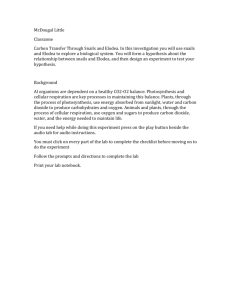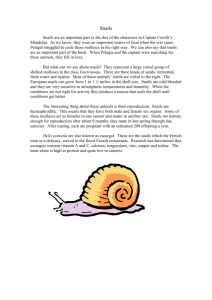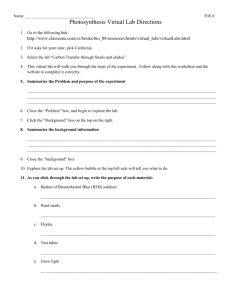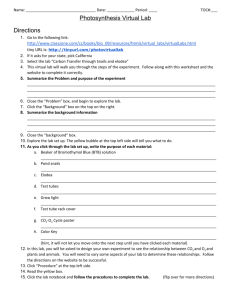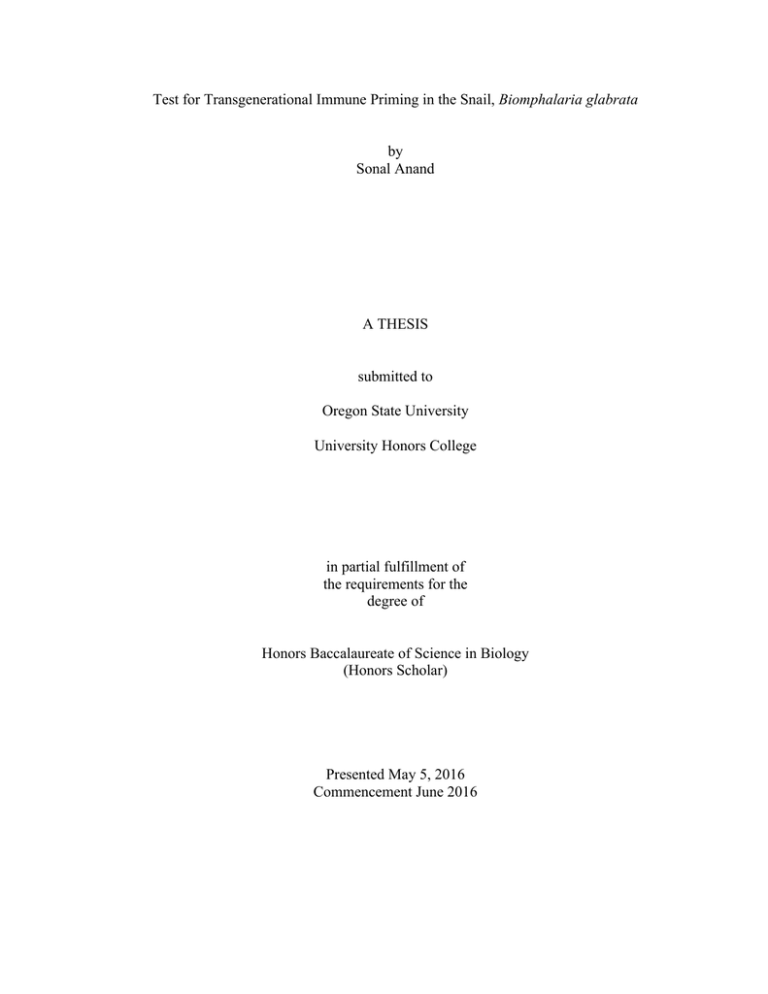
Test for Transgenerational Immune Priming in the Snail, Biomphalaria glabrata
by
Sonal Anand
A THESIS
submitted to
Oregon State University
University Honors College
in partial fulfillment of
the requirements for the
degree of
Honors Baccalaureate of Science in Biology
(Honors Scholar)
Presented May 5, 2016
Commencement June 2016
AN ABSTRACT OF THE THESIS OF
Sonal Anand for the degree of Honors Baccalaureate of Science in Biology presented
on May 5, 2016. Title: Test for Transgenerational Immune Priming in the Snail,
Biomphalaria glabrata .
Abstract approved:
______________________________________________________
Michael Blouin
Transgenerational immune priming occurs when an adult is exposed to a
parasite or other pathogen and then transmits information to its offspring through
protective phenotypes to cope with the same pathogen (Moret, 2006). There has been
evidence for transgenerational immune priming in various invertebrates (Tidbury et
al. 2011). Here we tested for the presence of transgenerational immune priming in the
Biomphalaria glabrata snails when challenged by exposure to the Schistosoma
mansoni parasite. The experimental parent generation was challenged with a parasitic
environment, while the control parent generation was not. The results were then
determined based on the resistance or susceptibility of the F1 offspring generation.
We found that parental challenge did not enhance offspring immunity through
transgenerational immune priming.
Key Words: Transgenerational immune priming, Schistosomiasis, Biomphalaria
glabrata, Schistosoma mansoni
Corresponding e-mail address: anands@oregonstate.edu
©Copyright by Sonal Anand
May 5, 2016
All Rights Reserved
Test for Transgenerational Immune Priming in the Snail, Biomphalaria glabrata
by
Sonal Anand
A THESIS
submitted to
Oregon State University
University Honors College
in partial fulfillment of
the requirements for the
degree of
Honors Baccalaureate of Science in Biology
(Honors Scholar)
Presented May 5, 2016
Commencement June 2016
Honors Baccalaureate of Science in Biology project of Sonal Anand presented on
May 5, 2016.
APPROVED:
Michael Blouin, Mentor, representing The Department of Integrative Biology
Michelle Steinauer, Committee Member, representing The Department of Basic
Medical Sciences, College of Osteopathic Medicine of the Pacific Northwest
Clint Sergi, Committee Member, representing The Department of Integrative Biology
Toni Doolen, Dean, University Honors College
I understand that my project will become part of the permanent collection of Oregon
State University, University Honors College. My signature below authorizes release
of my project to any reader upon request.
Sonal Anand, Author
Acknowledgements
First, I would like to thank my mentor, Dr. Michael Blouin, for the guidance
he has provided in my thesis writing process and time he has spent patiently
explaining concepts to me. I would also like to thank Dr. Michelle Steinauer for her
willingness to incorporate me in the lab when I was a sophomore and taking the time
to review this project for my defense. Thank you to Clint Sergi for spending a
considerable amount of time answering my questions, providing me with relevant
literature, and teaching me numerous laboratory techniques. Your guidance has
helped me grow as a researcher and scientist.
I would like to express my gratitude to Mudra, Sid, Tanvi, Lauren, and Josey
for their moral support throughout this process. Thank you for sitting through longwinded explanations of my research and allowing me to practice my defense
presentation on you all. Finally, I would like to thank my family for their constant
support, love and encouragement. You have all played an immense role in completing
this project.
Table of Contents
Page Number
Introduction……………………………………………………………………….…1
Methods…………………………………………………………………………….. 5
Results
(a) Infection rate results…………………………………………………….9
(b) Strength of Infection Results……………………………………………10
Discussion…………………………………………………………………………..12
References………………………………………………………….…………….…14
Test for Transgenerational Immune Priming in the snail,
Biomphalaria glabrata
Sonal Anand
Introduction:
Schistosomiasis
Currently, over 207 million people are estimated to be infected with
schistosomiasis (Magaisa et al, 2015). Schistosomiasis is a parasitic disease
transmitted by a snail intermediate host through contaminated water. Chronic
schistosomiasis affects many people living in rural areas with poor sanitation
throughout Africa and South America. Children have shown greater infection rates
than adults in affected regions as they spend more time swimming and bathing in
water containing infectious cercariae (Magaisa et al, 2015).
The species Biomphalaria glabrata are freshwater snails that act as the
intermediate host of the Schistosoma mansoni parasite in the new world. Human
contact with water containing infected snail hosts can lead to the contraction of
schistosomiasis. The infectious form of the parasite, cercariae, emerges from the snail
host into the water. Cercariae are able to swim in water as well as penetrate human
skin. Once cercariae has entered the body, it will move through blood vessels and
lymphatic system to mature in the body, specifically in the liver and small intestine
1
(Magaisa et al., 2015). This disease is difficult to control in rural areas as the parasites
are able to enter the water sources when infected humans and animals defecate in the
water. The parasitic eggs then hatch in the water as miracidia and infect the
intermediate host: Biomphalaria glabrata.
The current drug of choice to treat schistosomiasis is Praziquantel. It works by
killing the adult worms in infected individuals and is highly effective. It can be
successful in reducing the burden of the disease on communities when given out in
mass quantities to school age children. However, mass treatment programs can be
difficult to administer to all at-risk populations (Magaisa et al., 2015). Also, there is
concern about parasites developing resistance to the drug (Melman et al., 2009).
Many people are still at risk of being infected by schistosomiasis and much more
research still needs to be done in order to successfully control and decrease the spread
of this disease. Breaking the cycle of transmission through the intermediate snail host
is an alternate way to control the disease compared to treating humans with
Praziquantel. Therefore, it is important to learn more about the Biomphalaria
glabrata immune system and what controls resistance to infection for the snail.
Transgenerational Immune Priming
Not all heritable traits are written in the DNA sequence. Epigenetics and other
mechanisms can also lead to a form of “immune memory” inherited by future
generations (Harper, 2010). Following exposure to a parasite or virus, some
invertebrates have been found to exhibit increased immune protection in the next
2
generation, this is called transgenerational immune priming. A protective phenotype
can be transmitted to offspring by cytoplasmic factors, priming effects, histone
modification, DNA methylation, and other mechanisms that have not been fully
studied (Mousseau and Fox, 1998).
Transgenerational immune priming has been found in a number of
invertebrates proving that invertebrate immune systems are more sophisticated than
previously thought. For example there has been evidence that transgenerational
immune priming exists in the Plodia interpuctella (Lepidoptera) species, increasing
its future generation’s resistance to its natural DNA virus, Plodia interpunctella
granulosis virus (Tidbury et al. 2011).
In 2006 Transgenerational immune priming was discovered in the mealworm
beetle, Tenebrio molitor. There was Transgenerational phenotypic plasticity, which
increased immunity in the following generation. This was shown by increased levels
of anti-microbial activity in progeny of those parents that received a microbial
challenge (Moret, 2006).
In 2013 it was shown that Biomphalaria glabrata snails possess the ability for
within-generation immune priming to the Schistosoma mansoni parasite (Portela,
2013). This means that a snail that was previously exposed to a parasite undergoes
some form of genotype-dependent immune priming causing the snail to be resistant to
a subsequent homologous infection. The resistance of the snail was dependant on
which strain of parasite they were exposed to in the subsequent challenge (Portela,
2013). However to our knowledge there have been no studies on transgenerational
immune priming in Biomphalaria glabrata.
3
In nature Biomphalaria glabrata snails can be faced with attack from the
Schistosoma mansoni parasite multiple times within a generation as well as across
consecutive generations. In general, the parental environment predicts the general
quality of the progeny’s environment, so it would make sense that parents may
provide their offspring with phenotypes to cope with pathogens in their specific
environment (Moret, 2006). A specific advantage of transgenerational immune
priming is that it allows organisms to rapidly adapt to new pathogens in their
environment. We are interested to see whether exposure of parents to the parasite will
change the rate of infection in their progeny. This experiment will provide important
information about host-parasite dynamics of the disease schistosomiasis.
Here we assess whether exposure to the Schistosoma mansoni parasite leads to
immune priming transgenerationaly in Biomphalaria glabrata snails. Specifically we
examined the effect of parasite exposure in the parent generation on the rates of
subsequent infection in the progeny after being challenged by the same parasite,
Schistosoma mansoni.
4
Methods:
Ethics Statement
Animals that were used in this research at Oregon State University are covered by our
Institutional Animal Care and Use Committee (IACUC). We also use an approved
Animal Care and Use Proposal (ACUP), which is approved by the IACUC.
Maintaining the Schistosome parasite
We used both mice and hamsters to maintain the Schistosome parasite and to produce
miracidia for challenge experiments. The mice were infected through contact with
water containing cercariae. The infected rodents were then euthanized in order to
dissect and remove livers containing parasitic eggs. The miracidum then hatched out
of the parasitic eggs when exposed to light. The miracidia were then collected in
order to challenge the Biomphalaria glabrata snails.
Inbred lines of Biomphalaria glabrata
We used Line 121 and 125 of previously established inbred lines of Biomphalaria
glabrata to conduct the experiment and duplicate it. These lines have been
maintained in separate populations for a number of generations. Twenty-four snails
from each line were chosen based on their size and were between 4-6 mm in
5
diameter. Twenty-four snails of each line were exposed to the Schistosoma mansoni
parasite. Another 24 snails from each line were kept unchallenged to provide a
control. The unchallenged snails were kept separated but in identical tanks. Snails
from each group, line 121 exposed and control and line 125 exposed and control,
were divided into 2 groups of 12 snails each and kept in identical tanks. The
challenged parent snails began laying eggs approximately 7 days after the challenge.
The next generation of snails was collected and separated from the parent generation
6 weeks post parental challenge, in order to eliminate any breeding between snails
and offspring. These F1 offspring were then challenged to test whether offspring of
challenged parents were more resistant than offspring of control parents.
Challenging of Biomphalaria glabrata
Each of the 48 challenged snails, 24 from line 121 and 24 from line 125, were placed
in separate wells at the time of the challenge. They were placed in wells that
contained 5 miracidia each. They were exposed to miracidia for 24 hours then placed
back into separated tanks.
Twenty-one snails from the F1 generation of line 121 exposed and control parents,
and 21 snails from the F1 generation of line 125 control parents and 22 snails from
line 125 exposed parents were collected. The separated F1 offspring of snails were
then challenged when they reached the ideal size of 4-6mm using the same
challenging format described above.
6
Normal living conditions of Biomphalaria glabrata
The Biomphalaria glabrata snails were kept in a room at 26 degrees Celsius to
provide normal living conditions. They were separated into identical containers filled
with de-chlorinated water and supplemented with calcium. The snails were fed ad
libitum fresh lettuce 3 times a week.
Assay for infection
The F1 offspring were checked for infection 3 times: once each during the 5th, 6th, 7th,
and 8th week after challenge. The snails were checked by placing all collected
offspring in individual wells of de-chlorinated water then placing them under light for
an hour, which would cause cercariae to emerge from any infected snails. Then each
well was checked under the microscope for evidence of emerged cercariae. After this
check all snails were placed back into original tanks. During week 6 and 7 the snails
were also tested for infection strength. At each date of checking the total number of
surviving snails was noted as well as the number of snails infected at that point.
Strength of infection test
During the 6th and 7th week post challenge, the infected F1 generation snails were
tested for the strength of their infection. 2 drops of iodine were added to the well of
7
each infected snail. The numbers of cercariae were then counted under the
microscope. The cercariae were counted twice for each infected snail and these
numbers were averaged to show a more precise count. This test was conducted in
order to compare the difference in number of cercariae that emerged from the infected
progeny of the exposed parents compared to the infected progeny of the control
parents.
Statistical Analysis
A fisher’s exact test was conducted to compare the proportion of infected snails
between the control and exposed progeny of each line. An ANOVA was done to
study whether infection strength differed between F1s from exposed vs. control
parents.
ANOVA model:
We used a two-way ANOVA to test the effects of snail treatment and line as the two
independent variables on the number of average cercariae count produced as the
dependent variable. This analysis was done separately on snails that were shedding
on week 6 and on snails that were shedding on week 7. This is because individual
snails were not marked and were housed in groups, so I could not know which snails
that were observed on week 6 were the same as snails observed on week 7.
8
Results:
(a) Infection rate results
Offspring of
Control
Parents- Line
125 [N=20]
Infected
Offspring
of Exposed
ParentsLine 125
[N=19]
13
8
Uninfected
6
12
P value*= 0.1110
Infected
Offspring
of Exposed
ParentsLine 121
[N= 20]
5
Offspring
of Control
ParentsLine 121
[N=19]
3
Uninfected
15
15
P value*= 0.6968
*The P value was calculated using a Fisher’s exact test comparing exposed and
control groups
The two-tailed P value of both the lines show that the association between control and
exposed groups is considered to be not statistically significant. This shows that there
is no overall effect of parental exposure. Not only is the result not what we predicted,
the trend is in fact in the opposite direction from what we predicted. Slightly more F1
snails were infected from exposed parents than from control parents in both lines.
9
Infec0on Rate Results Line 125 Offspring of Control Parents Offspring of Exposed Parents Line 121 0 20 40 60 80 100 Infec0on Rate (%) Fig. 1. This graph shows the Infection rates of 2 independent lines of Biomphalaria
glabrata snails during week 8. Error bars are one standard deviation of the estimate of
the proportion. The control group was the progeny of snails that were not previously
challenged with Schistosoma mansoni. The experimental group was the progeny of
snails that had been challenged with Schistosoma mansoni.
(b) Strength of Infection Results:
Line 125 Control
Progeny
Line 125
Exposed Progeny
Line 121 Control
Progeny
Line 121
Exposed Progeny
Average Parasite
Count from
infected F1
offspring –Week
6
214
Average Parasite
Count from
infected F1
offspring –Week
7
150
Average Parasite
Count from infected
F1 offspring- Week 6
and 7 averaged
271
301
286
230
293
262
274
459
367
182
10
Fig. 2. These graphs show the strength of infection for both lines. Each plot is
separated in by treatment (control (C) vs. exposed (E)). The data points are also
separated by weeks. Each data point represents an individual snail that was shedding
cercariae on the week of observation. Note that points in week 6 cannot be matched
with points in week 7 because we did not mark individual snails.
ANOVA statistical test results:
Week 6:
P Value: 0.449 for treatment groups (exposed vs. control)
P Value: 0.691 for lines (line 121 vs. line 125)
Week 7:
P Value: 0.046 for treatment groups (exposed vs. control)
P Value: 0.065 for lines (line 121 vs. line 125)
These P values show that there is no statistical difference between the means of the
control and exposed group either within each line or between both the lines during
week 6. More snails were observed to be shedding during week 7 than week 6, and
11
there was a marginally statistically significant difference (p = 0.046) in the average
cercariae counts when comparing the two treatments groups (progeny of exposed vs.
progeny of control parents). Furthermore, the trend is in the opposite direction from
expectation, showing stronger infections in the progeny of exposed offspring than in
the control progeny. This result is not what we predicted, as we thought there would
an infection strength reducing effect of transgenerational immune priming in the
progeny of the challenged parents.
Discussion:
Our results show that there is no evidence of transgenerational immune priming in
Biomphalaria glabrata snails in response to challenge by the Schistosoma mansoni
parasite. The low sample sizes of this experiment might have caused low statistical
power to detect a difference in the infection rates of the exposed vs. control progeny
Biomphalaria glabrata snails. However, the trends from this experiment, both in
terms of percent infected and in terms of infection intensity per infected snail, are in
the opposite direction from what we predicted. This leads us to believe that there
really is no strong transgenerational immune priming in this system, rather than a
failure to detect it owing to low statistical power. This result suggests that the
Biomphalaria glabrata snails rely on their own environment and own genetic make
up, not their parent’s, in order to display resistance to the Schistosoma mansoni
parasite. However, this does not mean that there is no transgenerational immune
priming in the Biomphalaria glabrata snails, as this experiment is specific to it’s
12
interaction with the Schistosoma mansoni parasite. There may be potential
transgenerational immune priming in the snails when exposed to a different parasite,
virus, or bacteria.
One possible reason we did not see evidence of transgenerational immune priming
could be that the Biomphalaria glabrata snails in the parent generation had already
formed their eggs before they were challenged. At any time, unpackaged ova are most
likely spread throughout the reproductive tract of the snail (Boyle and Yoshino,
2000). Although the eggs are at different stages of development we cannot be sure
that epigenetic or other effects caused by parental challenge were inherited by the F1
progeny that we collected for this experiment. If eggs were already present and
developed at the point of parental challenge, this would have most likely have not
allowed for any epigenetic effects from the parent to occur in the F1 progeny. If this
experiment were repeated it would be beneficial to check eggs laid by the parent
generation several weeks after challenge. This would allow for the inclusion of new
gametes that were created post parental challenge to ensure a better chance of
observing any epigenetic or other changes in the offspring.
One interesting result is that we found higher infection rates and a barely statistically
significant increase in cercariae counts for the progeny of the exposed parents
compared to the progeny of the control parents. This trend in cercarial counts was
seen in the data from both week 6 and week 7, although only the data from week 7
had a significant p-value, presumably owing to the larger sample size in week 7. If
13
this result is a general phenomenon, one possible explanation is a cost of resistance in
the parental generation leading them to produce lower quality of eggs. This could
have led to weaker progeny of the exposed parents, which would account for the
greater strength of infection in those snails.
References:
1. Boyle, J P, and T P Yoshino. “The Effect of Water Quality on Oviposition in
Biomphalaria Glabrata (Say, 1818) (Planorbidae), and a Description of the
Stages of the Egg-Laying Process.” Journal of Molluscan Studies 66.2000
(2000): 83–93. Web.
2. Harper, Lawrence V. “Trans-Generational Epigenetic Inheritance.” Handbook of
Developmental Science, Behavior, and Genetics (2010): 434–465. Web.
3. Magaisa, Kundai et al. “A Review of the Control of Schistosomiasis in South
Africa.” South African Journal of Science 111.11-12 (2015): 32–38. Web.
4. Melman, Sandra D. et al. “Reduced Susceptibility to Praziquantel among Naturally
Occurring Kenyan Isolates of Schistosoma Mansoni.” PLoS Neglected Tropical
Diseases 3.8 (2009): n. pag. Web.
5. Moret, Yannick. “‘Trans-Generational Immune Priming’: Specific Enhancement of
the Antimicrobial Immune Response in the Mealworm Beetle, Tenebrio
Molitor.” Proceedings. Biological sciences / The Royal Society 273.1592 (2006):
1399–405. Web.
14
6. Mousseau, Timothy A., and Charles W. Fox. “The Adaptive Significance of
Maternal Effects.” Trends in Ecology and Evolution 13.10 (1998): 403–407.
Web.
7. Portela, Julien et al. “Evidence for Specific Genotype-Dependent Immune Priming
in the Lophotrochozoan Biomphalaria Glabrata Snail.” Journal of Innate
Immunity 5.3 (2013): 261–276. Web. 4 Apr. 2016.
8. Tidbury, Hannah J, Amy B Pedersen, and Mike Boots. “Within and
Transgenerational Immune Priming in an Insect to a DNA Virus.” Proceedings
of the Royal Society B: Biological Sciences 278.1707 (2011): 871–876. Web
15



